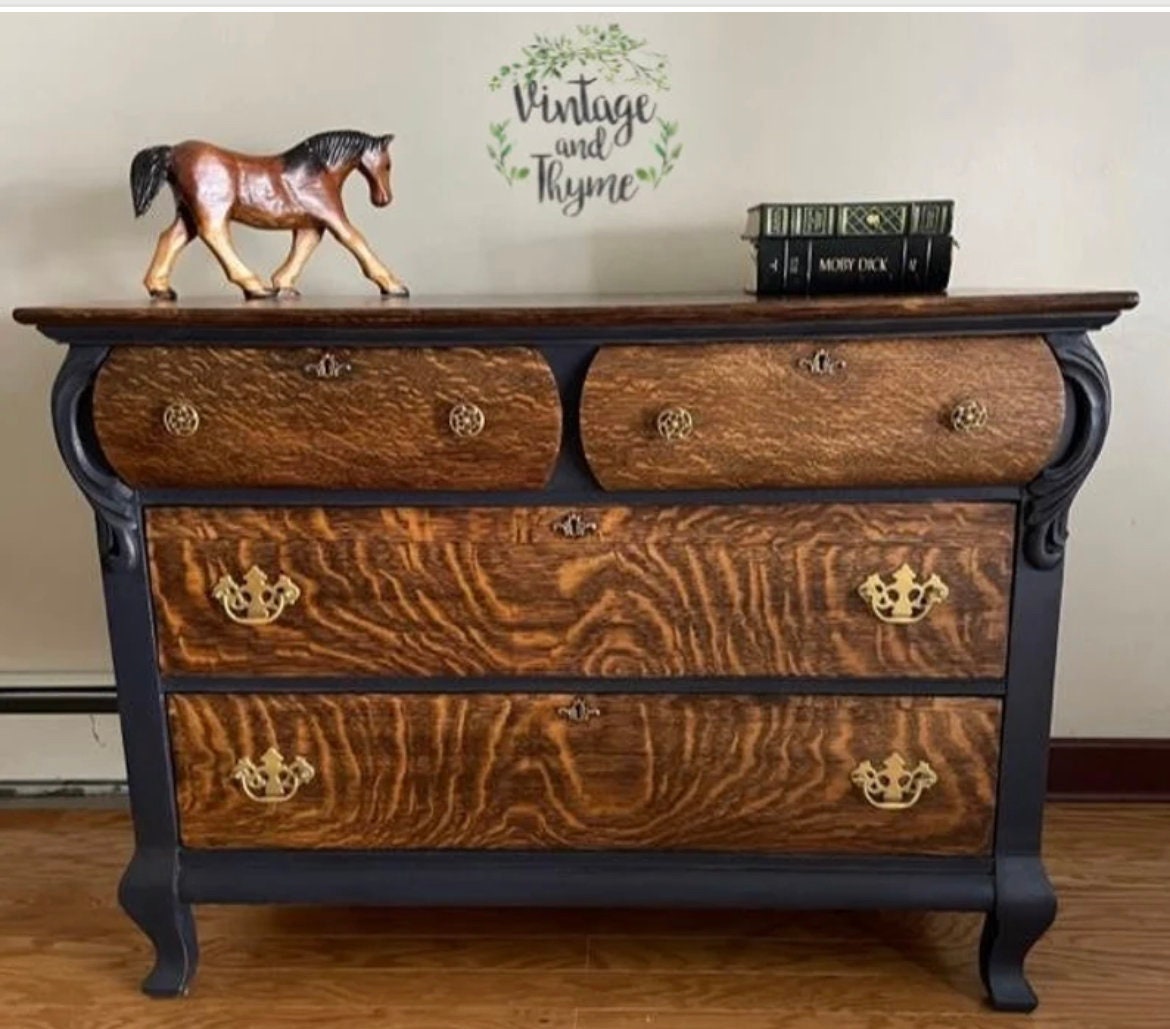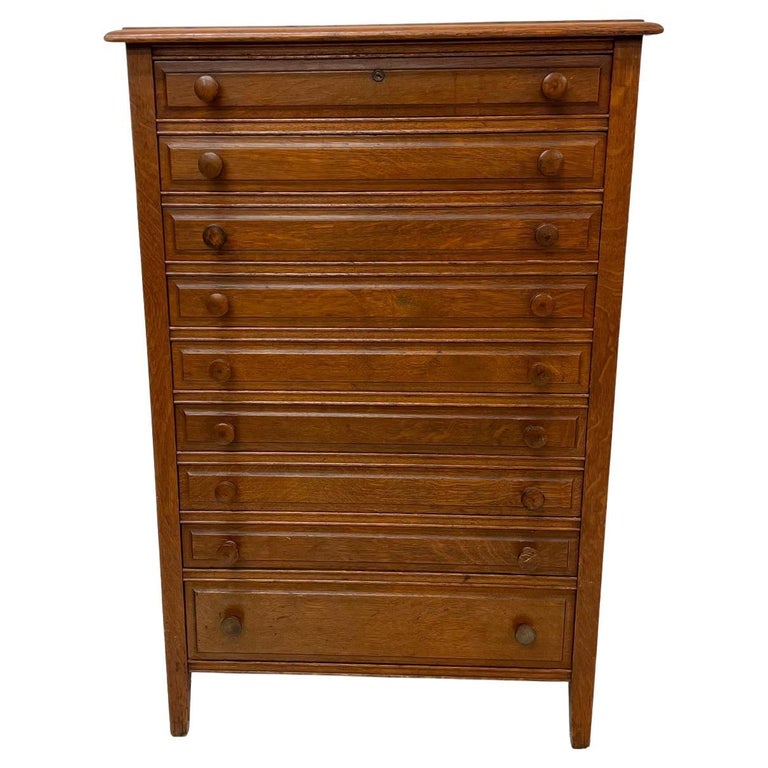The History and Characteristics of Antique Tiger Oak File Cabinets

Antique tiger oak file cabinets are a testament to the enduring beauty and practicality of this distinctive wood. The rich history of tiger oak and its evolution as a favored material for furniture, particularly file cabinets, reveal its unique characteristics and the artistry that went into crafting these enduring pieces.
The Origins and Evolution of Tiger Oak
Tiger oak, a variety of white oak, gained popularity in the late 19th and early 20th centuries, coinciding with the rise of the Arts and Crafts movement and the Victorian era. This period saw a shift towards natural materials and handcrafted furniture, making tiger oak a highly sought-after wood. Its distinctive grain patterns, reminiscent of tiger stripes, added a touch of elegance and sophistication to furniture designs.
The use of tiger oak for file cabinets emerged as office spaces evolved and the need for efficient storage and organization increased. The sturdy nature of tiger oak made it ideal for constructing durable and functional file cabinets, while its aesthetic appeal enhanced the overall look of the office.
Distinctive Features of Tiger Oak
Tiger oak possesses a unique combination of features that set it apart from other wood varieties. Its grain patterns, characterized by bold, swirling lines, create a visually captivating effect. The color variations range from warm honey hues to rich, deep browns, adding depth and dimension to the wood. Tiger oak is also known for its durability, resistance to scratches and dents, and ability to withstand the test of time.
Timeline of Antique Tiger Oak File Cabinet Design
Antique tiger oak file cabinets have evolved through various design periods, each reflecting the prevailing styles and trends of its time. Here’s a timeline highlighting key features of these periods:
- Late 19th Century: This era saw the emergence of the Arts and Crafts movement, which emphasized handcrafted furniture and natural materials. Tiger oak file cabinets from this period often featured simple, functional designs with clean lines and minimal ornamentation. The focus was on creating sturdy, practical pieces that blended seamlessly with the surrounding environment.
- Early 20th Century: The early 20th century saw a shift towards more elaborate designs, influenced by the Victorian era. Tiger oak file cabinets from this period often featured intricate carvings, decorative hardware, and a more ornate aesthetic. These pieces were often crafted with a high level of detail, showcasing the skill and artistry of the furniture makers.
- Mid-20th Century: The mid-20th century saw the rise of modernism and a renewed focus on functionality and simplicity. Tiger oak file cabinets from this period often featured clean lines, geometric shapes, and a minimalist approach to ornamentation. The focus was on creating functional pieces that were both practical and aesthetically pleasing.
Identifying and Appraising Antique Tiger Oak File Cabinets

Identifying and appraising antique tiger oak file cabinets requires a keen eye for detail and a solid understanding of the factors that influence their value. This process involves distinguishing genuine antiques from reproductions, recognizing common markings and manufacturer information, and evaluating the factors that contribute to their monetary worth.
Identifying Genuine Antique Tiger Oak File Cabinets
To ensure you’re dealing with a genuine antique, several key characteristics distinguish tiger oak file cabinets from reproductions or imitations.
- Wood Grain and Color: Antique tiger oak exhibits a distinctive, bold grain pattern with rich, warm brown tones. The grain often resembles the stripes of a tiger, hence the name. Reproductions may have a less pronounced grain or a more uniform color.
- Construction Techniques: Antique cabinets were often crafted using traditional joinery methods like mortise and tenon joints, dovetail joints, and hand-cut details. Reproductions may utilize modern techniques like glue and screws, which are less durable and visually less appealing.
- Hardware: Antique hardware, such as hinges, pulls, and locks, is typically made of solid brass or iron and often features intricate designs or patina. Reproductions may have less detailed or less durable hardware.
- Finish: Antique tiger oak file cabinets often have a rich, multi-layered finish that has aged gracefully over time. Reproductions may have a more uniform or glossy finish.
Common Markings and Manufacturer Information
Antique tiger oak file cabinets often bear markings or labels that can help identify their origin and manufacturer. These markings may be found on the interior or exterior of the cabinet, and can provide valuable information for authentication and appraisal.
- Manufacturer’s Name or Logo: Look for the name or logo of the manufacturer, which may be stamped, engraved, or painted on the cabinet. This information can be used to research the manufacturer’s history and production dates.
- Date Stamps: Some cabinets may have date stamps that indicate the year of manufacture. These stamps can be found on various parts of the cabinet, such as the drawer bottoms or the back panel.
- Patents or Trademarks: Antique cabinets may also bear patents or trademarks, which can help identify the manufacturer and the specific model of the cabinet.
Factors Influencing Value
The value of an antique tiger oak file cabinet is influenced by a combination of factors, including its condition, rarity, craftsmanship, and historical significance.
- Condition: The condition of the cabinet is a major factor influencing its value. A well-preserved cabinet with minimal wear and tear will command a higher price than a damaged or heavily restored piece.
- Rarity: The rarity of a specific model or manufacturer can significantly impact its value. Cabinets produced in limited quantities or by renowned manufacturers are often more valuable.
- Craftsmanship: The quality of craftsmanship is also a key factor. Cabinets with intricate details, high-quality materials, and skilled construction techniques are typically more valuable.
- Historical Significance: The historical significance of a cabinet can also influence its value. Cabinets associated with notable individuals or events may command higher prices.
Restoring and Preserving Antique Tiger Oak File Cabinets

Restoring and preserving an antique tiger oak file cabinet is a rewarding endeavor that involves a careful approach to cleaning, polishing, and addressing any damage. This process allows you to enhance the cabinet’s natural beauty and ensure its longevity for generations to come.
Cleaning and Polishing
Proper cleaning and polishing are essential steps in restoring an antique tiger oak file cabinet. These procedures remove dirt, grime, and old polish, revealing the wood’s natural grain and color.
- Dusting: Begin by dusting the cabinet thoroughly with a soft, dry cloth to remove loose dirt and debris. Avoid using feather dusters, as they can scratch the delicate finish.
- Cleaning: Use a mild cleaning solution specifically designed for antique furniture. Mix a few drops of dish soap with warm water and apply it to a soft cloth. Gently wipe down the cabinet’s surface, paying attention to crevices and corners. Avoid using harsh chemicals or abrasive cleaners, as these can damage the finish.
- Polishing: After cleaning, apply a high-quality furniture polish specifically formulated for antique wood. Apply the polish sparingly to a soft cloth and rub it gently in a circular motion. Allow the polish to dry completely before buffing it with a clean, dry cloth to achieve a lustrous shine.
Addressing Common Issues
Antique tiger oak file cabinets may exhibit common issues such as scratches, dents, and faded finishes. Addressing these problems requires specialized techniques and materials.
- Scratches: For minor scratches, use a touch-up pen or marker that matches the cabinet’s finish. Apply the pen to the scratch, gently blending it into the surrounding wood. For deeper scratches, consider using a wood filler or a specialized scratch remover.
- Dents: Dents can be minimized using a damp cloth and a warm iron. Place a damp cloth over the dent and press the iron on low heat. The steam will help to raise the dented wood. For deeper dents, consult with a professional furniture restorer.
- Faded Finishes: Faded finishes can be restored by applying a new layer of polish or by using a wood conditioner. Apply the polish or conditioner sparingly to a soft cloth and rub it gently in a circular motion. Allow the product to dry completely before buffing it with a clean, dry cloth.
Preserving the Wood’s Beauty
Protecting the wood’s natural beauty requires proper care and maintenance.
- Avoid Direct Sunlight: Direct sunlight can fade the wood’s finish and cause it to become brittle. Place the cabinet away from direct sunlight or use curtains or blinds to filter the light.
- Maintain Humidity: Tiger oak is susceptible to changes in humidity. Ideal humidity levels for antique wood are between 40% and 60%. Use a humidifier during dry seasons to maintain optimal humidity levels.
- Regular Cleaning and Polishing: Regular cleaning and polishing help to prevent dirt and grime from accumulating and damaging the finish. Clean and polish the cabinet every few months to maintain its beauty.
Finding Qualified Professionals
For complex restoration or repair work, it is recommended to consult with a qualified professional.
- Antique Furniture Restorers: Antique furniture restorers have the expertise and experience to handle complex restoration projects. They can assess the cabinet’s condition, recommend appropriate treatments, and perform the necessary repairs.
- Woodworking Professionals: Woodworking professionals can provide repairs for structural damage, such as broken drawers or loose joints. They can also create custom pieces to replace missing or damaged components.
The antique tiger oak file cabinet, with its intricate carvings and rich patina, exudes a timeless elegance that can transform any office space. While the cabinet’s solid wood construction provides enduring functionality, the integration of glass finish kitchen cabinet doors in a contemporary setting can create a visually stunning juxtaposition, showcasing the beauty of both traditional and modern design elements.
Similarly, the antique file cabinet’s enduring quality serves as a reminder of the craftsmanship and artistry that were once prevalent, emphasizing the importance of selecting durable and aesthetically pleasing furniture for the modern home or office.
An antique tiger oak file cabinet, with its intricate carvings and sturdy construction, embodies a bygone era of craftsmanship. While it may lack the modern conveniences of a tall white corner cabinet with glass doors , its timeless elegance and enduring quality make it a cherished piece for any discerning collector.
The antique file cabinet, with its history and character, stands as a testament to the enduring appeal of classic design.
